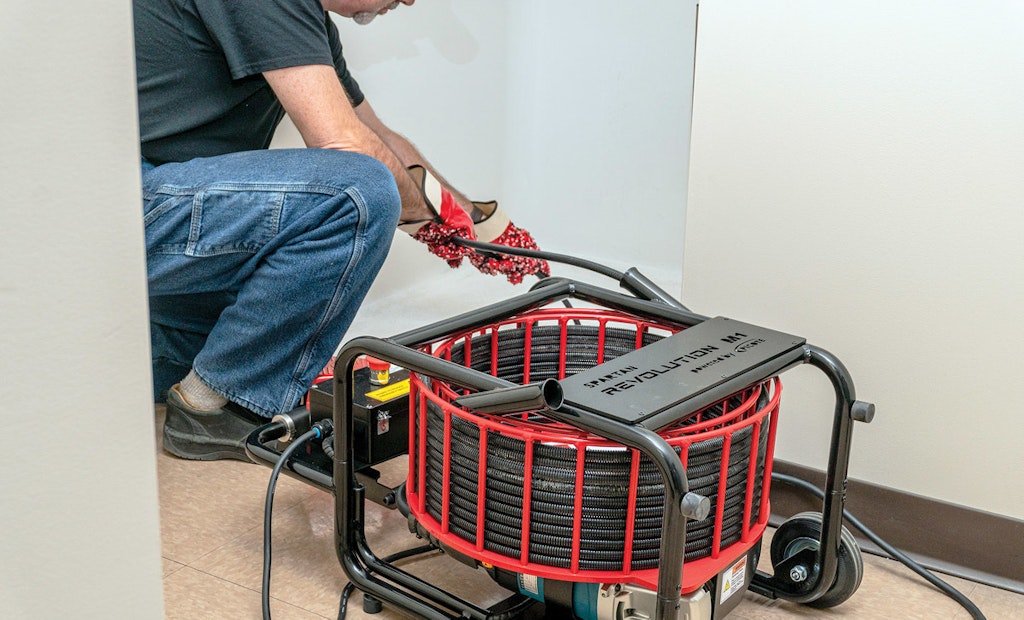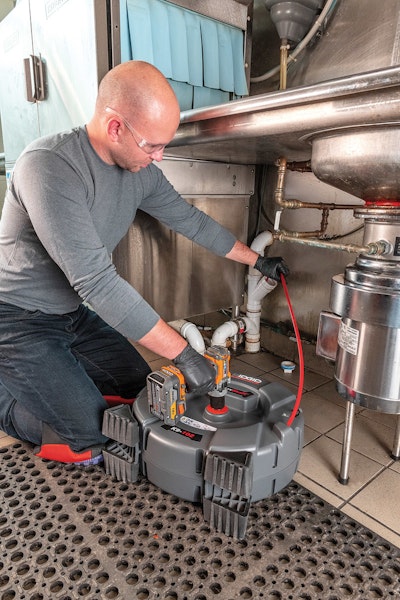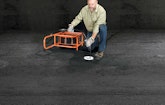
Flexshaft machines are designed for fast and efficient drain cleaning, including the removal of soft blockages, scale, calcium buildup, tree roots and concrete. Here a contractor uses a Spartan Tool Revolution M1 to clear a drainline.
Interested in Cleaning?
Get Cleaning articles, news and videos right in your inbox! Sign up now.
Cleaning + Get AlertsFlexible-shaft machines — flexshaft machines for short — are highly useful tools for clearing and cleaning pipes. They allow plumbers and drain cleaners to precisely target and remove clogs in a manner that is safe, efficient and appreciated by customers.
The nitty-gritty
Whether powered by their own onboard electric motor or a connected electric hand drill, “flexible-shaft machines employ a swiftly rotating rod or wire coil — much like a speedometer cable — inside a flexible hollow tube or hose,” says David Dunbar, national sales manager with General Pipe Cleaners, which sells a range of flexshaft systems under the Flexi-Rooter brand name. “A high-speed motor connects to the rod’s back end, and that drives a cutting tool attached to the front end.”
The big plus: “With traditional drain machines, the cable spins at lower speeds and uses high torque to ‘poke a hole’ in blockages,” says Shelby Gerl, RIDGID’s product manager for FlexShaft drain cleaning machines. “With FlexShaft machines, the cable spins about 4 to 5 times faster than traditional cable machines, using low torque and high speed to clean wall to wall. FlexShaft cables also break blockages down around the circumference of the pipe rather than just penetrating obstructions, leaving you with a truly clean and rehabilitated pipe.”
“Flexible-shaft machines spin at speeds noticeably higher than those of conventional cable-type drain cleaners,” Dunbar agrees. “Users also quickly discovered that the cutting device — often carbide-tipped chains rotating at speeds of 2,000 rpm or greater — not only milled pipe insides, but removed tree roots effectively. As well, when outfitted with the correct cutting tool and properly used, the combination perfectly prepares pipe insides to accept material used in the relining procedure.”
The range of these flexible pipe cleaners is also impressive. For instance, “RIDGID FlexShaft machines quickly and efficiently deliver wall-to-wall clean in 1 1/4-inch to 6-inch residential and commercial pipes up to 125 feet,” Gerl says. “They utilize various chain knockers that expand to the size of the pipe to quickly clean the entire pipe.”
Enhanced operator safety is a further feature of flexshaft machines. Traditional drain cleaning machines use an exposed cable that builds up torque as the cable’s cutting end engages a blockage. In a flexshaft machine, the cable spins inside of a housing made of nylon or some other durable material. This sheath protects the operator’s hands and allows for easy wipedowns as the cable is retracted from the pipe.
Designed to work in tandem
The flexshaft machine is designed to work alongside conventional drain cleaning machines, giving drain cleaners and plumbers a one-two punch to clear and clean clogged pipes.
“FlexShaft machines are unique in that they offer an entirely new way to clean pipes,” Gerl says. “Conventional drain cleaning machines allow you to clear blockages using torque, while FlexShaft machines utilize high speed to completely scour the pipe walls.”
A conventional drain cleaner is used to open a pathway whenever the pipes are entirely blocked. Once this path exists, or if the pipe in question isn’t entirely blocked, a flexshaft machine can take its place to remove the rest of the blockage and clean the pipe’s walls.
“Our goal for the Spartan Tool Revolution line of high-speed flexible shaft machines was to continue bringing our customers the best quality drain cleaning machines,” notes Brian Elliott, Spartan Tool territory manager. “Flexshaft machines are definitely designed for fast and efficient drain cleaning and rehabilitation including removal of soft blockages, scale, calcium buildup, tree roots and concrete.”
The high speed, low torque of the flex-shaft’s spinning head — and the variety of tools that can be attached to it — makes all the difference. “Again, it’s very good at getting rid of root incursion,” Dunbar says. “As well, you can use a flexshaft machine as an effective pipe milling tool. In fact, the first time I heard about this technology, it was referred to as a ‘milling device,’ because these machines were being used to prepare the inside of cast iron pipes for pipelining.”
Strong, lightweight cables
The flexible, lightweight yet strong cable within the flexshaft’s protective housing — which carries the energy from the drive motor to the clog-clearing head — is central to this machine’s cleaning power.
“The balance of flexibility and strength in the cable is important because it allows you to easily navigate through traps and bends, while still being tough enough to clear blockages,” Gerl says. To provide this flexible strength, flexshaft cables “have multiple layers of individual wires that are tightly wound in alternating directions. The alternating wire layers add strength for operating the cables in both forward and reverse directions.”
“The cable is also lightweight,” Elliott adds, “which is crucial for the speeds at which the cable rotates.” This allows flexshaft machines like the Spartan Tool Revolution M1 “to work in P-traps, U-bends and pipes with multiple 90-degree bends.”
Worth noting: Although flexshaft multilayered wire cables are flexible, “when the cleaning end of the cable meets resistance, the layers tighten against each other making the shaft more rigid-like in performance,” Gerl says.
Using lightweight cables in flexshaft machines also reduces wear and tear on contractors. “They are far easier to use on long pipes than a big plumber’s snake that could weigh several hundred pounds if it’s a shaft device,” Dunbar says. “As well, an unenclosed snake can injure an operator’s hand as it moves, while the flexshaft’s cable is enclosed and thus safe.”
Other benefits
Beyond flexibility and safety, flexshaft machines offer many other benefits.
First, because their cables spin inside enclosed housings, these machines are much tidier to work with. Their lack of mess translates into cleaner job sites that take less time to clear while keeping customers happier.
Second, the flexshaft’s enclosed cable means that an inspection system can be used simultaneously to provide precise placement, monitor progress and provide something cool for the customer to watch. “This is a huge win for plumbers,” Gerl says. “They don’t have to put a camera down, pull it out and then try to clear a blockage, put the camera back down to make sure the blockage is clear. It’s a hassle that FlexShaft eliminates, meaning you save time on every job. This allows you to add more jobs to your day: Ultimately, we hope to help plumbers bring in more profits.”
The ability of flexshaft machines to provide true pipe cleaning does provide drain cleaners and plumbers with a new service to sell. “They can offer wall-to-wall cleaning at a premium versus traditional clearing of blockages,” Gerl says. “This allows contractors to offer their customers various options to enhance their marketability, increase their revenue and minimize callbacks.”
In fact, “flexshaft machines fill a void between jetters and cable machines,” says Elliott. “They can descale very effectively and are comparable to a jetter for grease removal. Flexshafts can also clean a line instead of just restoring flow. Again, this gives a business owner the ability to offer additional services to their customers.”
Flexshaft machines are tools that can help professionals do a better job for their customers in a cost-effective manner, while providing them with more services, better in-pipe surveillance, and a sense of security once the job is done.







